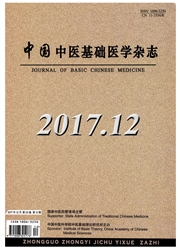

 中文摘要:
中文摘要:
风险预测模型研究是慢性非传染性疾病(简称慢病)防治的重要手段,但目前的疾病风险预测模型中缺乏中医证候学和症状学等方面内容。病证结合构建慢病风险预测模型的研究思路首先是以疾病发生或疾病终点指标作为目标结局变量,其次确定并采集与目标结局相关的关键信息,然后运用数理方法筛选中西医危险因素构建风险预测模型,最后评价风险预测模型的预测性能。常用的数学模型包括Logistic回归模型、Cox比例风险模型、人工神经网络、决策树模型、Markov模型、随机森林。此外在构建风险预测模型时需注意各种模型的适用条件、结局变量特征和影响因素的数据特点。
 英文摘要:
英文摘要:
The research on risk prediction model is the important strategy for prevention and treatment of chronic non- communicable diseases. However, there are lack of related contents about traditional Chinese medicine (TCM) syndrome and symptom in the prediction models. Firstly, the basis of building risk prediction model based on combination of disease and syndrome is to choose whether diseas occur or disease endpoint index as the target outcome. Secondly, the key influencing factors which are relative to the known outcome arc identified and collected. Thirdly, mathematical methods are chosen to screen TCM and western medicine risk factors, eventually to construct risk model. Fourthly, the performance of risk prediction model is evaluated. The common mathematical model include logistic regression analysis, Cox proportional hazard model, artificial neural network, decision tree model, Markov model, and random forest. In addition, we should pay attention to the application conditions, characteristic of outcome and influencing factors in the construction of risk prediction model.
 同期刊论文项目
同期刊论文项目
 同项目期刊论文
同项目期刊论文
 Variable selection using the optimal ROC curve: An application to a Traditional Chinese Medicine stu
Variable selection using the optimal ROC curve: An application to a Traditional Chinese Medicine stu 期刊信息
期刊信息
